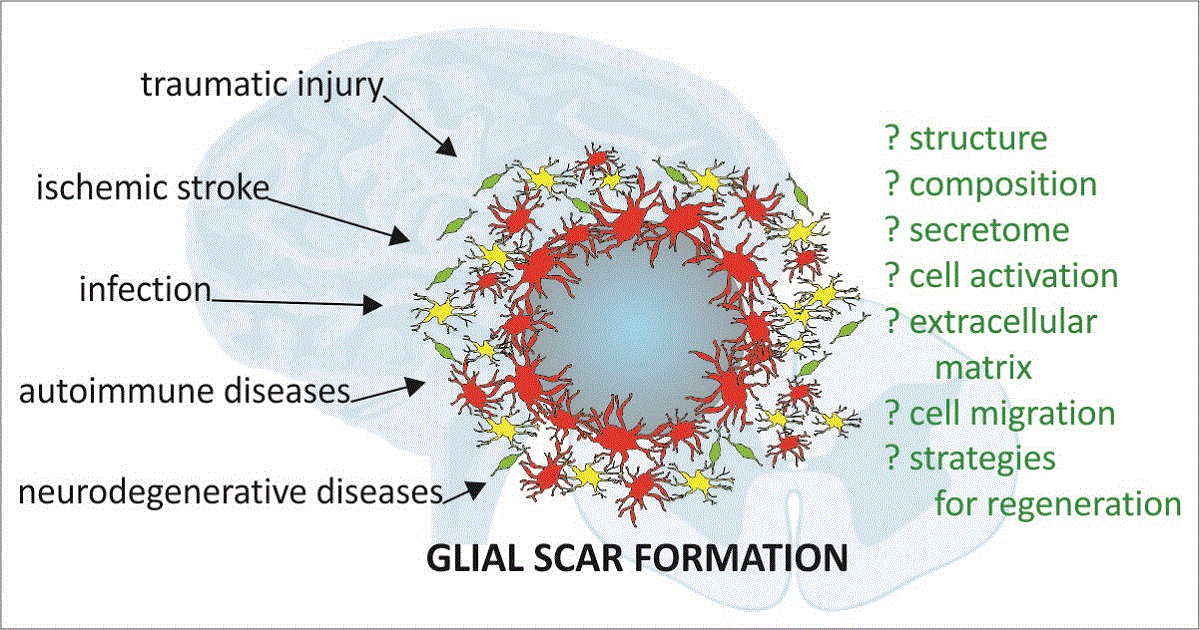Glial Scar: Formation and Regeneration
A special issue of Cells (ISSN 2073-4409). This special issue belongs to the section "Cells of the Nervous System".
Deadline for manuscript submissions: closed (30 April 2024) | Viewed by 32232

Special Issue Editors
Interests: NG2-positive progenitors; oligodendrocytes; myelinogenesis; astrocytes; microglia polarization; neuroreparative strategies
Interests: glial cell biology; neuron-glia crosstalk; ion channels and transporters; neurodegeneration; myelin repair; demyelinating diseases
Special Issue Information
Dear Colleagues,
Glial scar formation is a pathological feature shared by neurodegenerative CNS diseases, i.e., MS, PD, AD, and ALS. Glial scar formation, triggered by injuries to the nervous tissue, is associated with reactive gliosis, increased cell migration, and the expression of numerous active factors (such as interleukins, trophic factors, and extracellular matrix components). Thus, this multidimensional structure comprises multiple cellular and extracellular components secreted by the activated cells. It is formed predominantly by astrocytes, oligodendrocyte progenitors, and microglia/macrophages playing roles both in the immunomodulation and in the deposition (secretion) of scar components. On the one hand, glial scars are considered to exert beneficial effects associated with the limited spread of injury, but on the other hand, it is a hindrance to tissue regeneration.
Glial scar formation: Does it exert beneficial or detrimental effects on injury spread and tissue regeneration? This question will be addressed and discussed in many respects. This Special Issue aims to provide an overview of novel discoveries in the field of glial scar formation, its structure and composition, as well as proposed innovative strategies designed to promote tissue regeneration and restoration of its functions.
Dr. Joanna Sypecka
Dr. Francesca Boscia
Dr. Justyna Janowska
Guest Editors
Manuscript Submission Information
Manuscripts should be submitted online at www.mdpi.com by registering and logging in to this website. Once you are registered, click here to go to the submission form. Manuscripts can be submitted until the deadline. All submissions that pass pre-check are peer-reviewed. Accepted papers will be published continuously in the journal (as soon as accepted) and will be listed together on the special issue website. Research articles, review articles as well as short communications are invited. For planned papers, a title and short abstract (about 100 words) can be sent to the Editorial Office for announcement on this website.
Submitted manuscripts should not have been published previously, nor be under consideration for publication elsewhere (except conference proceedings papers). All manuscripts are thoroughly refereed through a single-blind peer-review process. A guide for authors and other relevant information for submission of manuscripts is available on the Instructions for Authors page. Cells is an international peer-reviewed open access semimonthly journal published by MDPI.
Please visit the Instructions for Authors page before submitting a manuscript. The Article Processing Charge (APC) for publication in this open access journal is 2700 CHF (Swiss Francs). Submitted papers should be well formatted and use good English. Authors may use MDPI's English editing service prior to publication or during author revisions.
Keywords
- CNS
- reactive gliosis
- inflammation
- scarring
- tissue cytoarchitecture
- neurorepair
Benefits of Publishing in a Special Issue
- Ease of navigation: Grouping papers by topic helps scholars navigate broad scope journals more efficiently.
- Greater discoverability: Special Issues support the reach and impact of scientific research. Articles in Special Issues are more discoverable and cited more frequently.
- Expansion of research network: Special Issues facilitate connections among authors, fostering scientific collaborations.
- External promotion: Articles in Special Issues are often promoted through the journal's social media, increasing their visibility.
- e-Book format: Special Issues with more than 10 articles can be published as dedicated e-books, ensuring wide and rapid dissemination.
Further information on MDPI's Special Issue policies can be found here.








